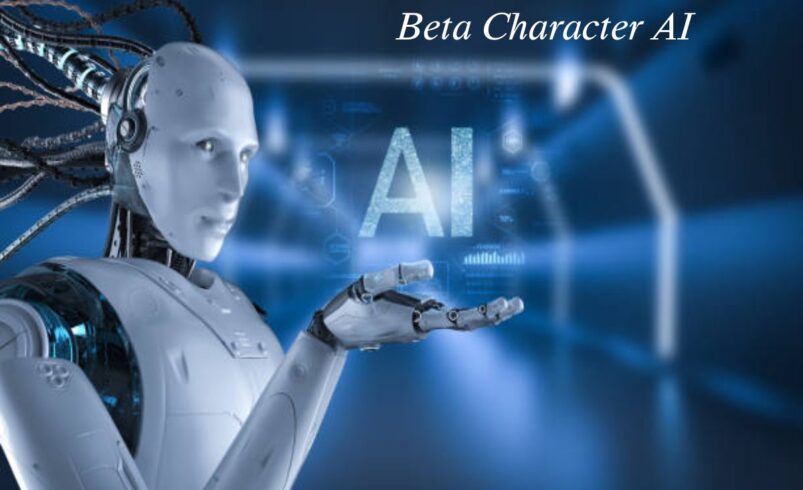In the modern world where technologies grows at a very fast rate, “Beta Character AI” becomes a crucial idea, which combines such aspects as development in artificial intelligence and new requirements of character-related applications. This article specifically focuses on the concept of Beta Character AI and how it fits into the current technology infrastructures and what its role might be for the further advancements in the field.
Understanding Beta Character AI

Beta Character AI means a particular aspect of artificial intelligence that was incorporated into models aimed at imitating or improving human beings’ personalities. These characters can be used in smart companions, video games, digital friends, and shopping/ecommerce bots. This is because the term ‘Beta’ is used to denote that these AI systems are not yet fully set and are already partially deployed and improved based on users’ response and statistical results.
Historical Context and Evolution
Character-based artificial intelligence is something that has developed since the seeds of computing were sown. At the beginning, AI characters are very simple and their primary function was to interact with fellow AI characters through simple rules. The first examples are ELIZA developed as a psychotherapist mimic in the 1960s, and recent chatbots like ALICE and Cleverbot. These proto-AI characters established the building blocks for better AI personalities but had problems in their capability to execute and create responses in the wanton manner of humans.
The use of machine learning and natural language processing was considered to be a turning point. With these development, AI system began to not only parse and comprehend human language but also generate human language. The subsequent breakthrough of deep learning provided deeper and more contextualised characters’ AI by expanding the integration of artificial intelligence.
Some of the features that can be incorporated in the development of Beta Character AI are as follows:
- Natural Language Understanding (NLU): New Generation Beta Character AI systems make use of sophisticated NLP for understanding the inputs typed in by the user. They can define context, determine user’s intent and offer corresponding answers, that makes interactions richer.
- Adaptive Learning: Beta works of Character AI systems can also include the use of learning algorithms which helps the system learn from interactions. This makes them learn continuously, and thus progress as their responses and subsequent behaviors can be enhanced based on users’ behaviors and patterns.
- Emotion Recognition: A new development that has emerged in character AI is the behaviour of perceiving or understanding emotions. Text, voice tone, or facial recognition allows Beta Character AI to understand the user’s emotions and respond based on that, thus improving user experience.
- Personalization: Beta Character AI systems are highly suitable for personification. Regarding their benefits, they can remain as memorizers of the user preferences, histories, and the context details to give answers that seem more personal to the users.
- Multi-modal Interaction: Newer generation of Self-Operating Beta Character AI interfaces can handle multiple channels of modulation of text, voice, and vision inputs. This makes it possible to create even more detailed experiences which are even more interactive… especially in contexts such as virtual assistants and interactive media.
Cases of using Beta Character AI
- Customer Service: In the sphere of customer relations, Beta Character AI provides the most revolutionary form of business and consumer connection. Virtual assistants and chatbots are used also in handling recurrent questions, answering and even in certain cases solving problems. They have round-the-clock coverage thus cutting down on the time required to resolve customer complaints.
- Entertainment and Gaming: Due to its effectiveness in making games better, the gaming industry has integrated Beta Character AI to its advancement. Autonomous characters in games are capable of showing versatile activity and respond to the player’s actions and therefore make games more interactive and unique.
- Virtual Companions: Beta Character AI can also be seen placed in the field of virtual companions as well. The use of these AI characters is in offering comfort through counselling, companionship and even humor. It is intended to mimic a person’s experience, thus providing the user with companionship and attention.
- Education and Training: When used in educational institutions, the Beta Character AI should be deployed as learning advisors or as virtual trainers. They deliver unique learning environment, using characteristics of the learner, such as the speed of study, and the assessment of the results produced by the learner with the goal to improve the educational process.
- Healthcare: AI characters are employed in the health care fields for communication with the patients, patient counseling, and administrative functions. They help with making appointments, answer questions related to health, and help with managing ongoing illnesses.
Challenges and Considerations

Despite the advancements, Beta Character AI faces several challenges and considerations:
- Ethical Concerns: AI characters involve some of the moral issues concerning privacy rights, consent, and even deception. Some of the key areas that must be ensured include the following. There is the need to have some form of transparency. When implementing the AI systems, it is necessary to stick to certain set ethical standards.
- Bias and Fairness: AI systems might re-enforce or even deepen social prejudices and cessions present in their data base. Bias handling is an important component to tackle while aiming at reducing barriers to equality.
- Security Risks: The admittance of AI characters in different applications lead to security threats. Including either data leakage or unwanted usage. It is imperative for the application to have strong security mechanisms and optimized methods for information security.
- Technical Limitations: However, the designed Beta Character AI framework has its own limitations. Such problems as inability to evaluate the context, inability to produce correct reactions. And inability to work with complex asking remain among the major problems for developers.
- User Acceptance: The features of Beta Character AI are much influenced by the acceptance and trust given by the user. The application of AI is highly effective when realistic AI characters. That are credible as well as beneficial to the user are established.
Beta Character AI: An Analysis of the Future〗
Based on the previous sections of the paper. Beta Character AI can be regarded as promising and capable of further development and integration into the existing schemes. Concomitantly, quantum computing, better neural networks, and other subsequent models of NLP can be expected to improve the AI characters.
This means that the future will be characterized by huge use of Beta Character AI. In all the sectors of our daily life. Increasing effective emotional models, deeper context awareness, and less avatars forced. Artificiality will being the next form of artificial intelligence characters.
Moreover, as AI keeps evolving, several critical issues include. Ethical concerns and policies that will dictate the creation and use of character-based smart systems. It is still important to incorporate usage of AI systems in a properly responsible manner. As well as ethical in order to gain maximum support from the public.
Conclusion
The advancement of Beta Character AI makes a special type of artificial intelligence. Which help to make more interaction, personalized, and involving in many application areas. Of course, it is not difficult to identify some challenges that are still to affect the Beta Character AI. But, at the same time. The continual development of this AI type presages better experiential ways of utilizing it in the future. Right now, Beta Character AI is poised to possibly become more and more integral to. The community and the society as technology does progress with time.
Also Read:

